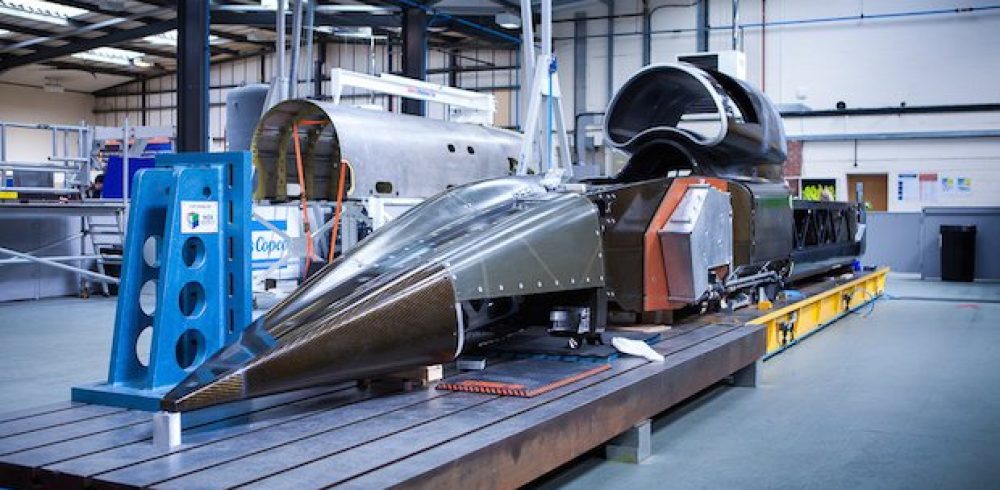Building Bloodhound : Stuart Nathan looks at the role that manufacturing technology has played in bringing Bloodhound SSC to life
The Land Speed Record is one of the most extreme tasks any engineering structure can undergo. By definition taking a structure into a situation no other structure has experienced, it requires extraordinary engineering; and the latest attempt at the record, the Bloodhound Supersonic Car (SSC), is no exception. Building it has required the expertise of the Nuclear Advanced Manufacturing Centre (NAMRC) in Sheffield and a variety of methods to make the components of the car, all of them to the highest possible standards and some of them representing firsts for industrial application.
Bloodhound is the very definition of an extreme project. Its goal is twofold: first to exceed the current record of 763mph later this year on a track in the desert of Northwest South Africa, at a dry lake bed called Hakskeen Pan. Its next task is to go even faster: following an engineering review back at its base in Bristol, the team will go back to Hakskeen in 2016 and attempt to run the car at 1000mph. This would represent the biggest jump in the land speed record in its history, which dates back to the early 20th Century, and impose enormous stresses on many of the carâs components.
To achieve this goal, the car is equipped with three types of engine, although only two actually propel the car. From zero to about 500mph, the car runs on the power of a Rolls-Royce EJ200 jet, the same types that powers the RAFâs Typhoon Eurofighters. Above this speed, driver Andy Green â the current land speed record holder â will trigger a hybrid rocket, burning solid synthetic rubber fuel with the help of high-test hydrogen peroxide oxidising agent squirted into the rocket by a pump powered by an 8-cylinder Jaguar Land Rover engine. For the first record attempt, Bloodhound will have a single rocket: for the 1000mph runs, it will use three.
Bloodhoundâs construction, which has been underway for around two years, has used a variety of materials and construction technologies to meet the balance between strength and lightness that a record-breaking vehicle needs. The upper chassis is supported on aluminium ribs, similar to those of old cargo aircraft, with a bonded titanium skin. Andy Greenâs cockpit is housed in a carbon-fibre monocoque safety cell. The lower chassis, which will be bombarded during the runs by dust and pebbles thrown up from the desert surface, is made of steel. Much of the rest of the car, such as the tail fin and the aerodynamic winglets which sit just ahead and below the driverâs position and on either side of the tail fin, are aerospace-grade aluminium. A few components, such as the driverâs wheel and the tip of the nose cone, are made of 3D-printed titanium; ballistic armour lines the backs of the wheel wells, to protect Green in the unlikely event of the wheels breaking up and being thrown against the body of the car. The wheels themselves are solid forged aluminium of a special, super-tough grade containing zinc.
The NAMRC made seven components for Bloodhound. Engineering lead Mark Elvin told MWP: âThe entire rear of the car was a product sponsorship. NAMRC wanted to show what off what their new machining equipment could do, so Smiths Group provided the material billets, the AMRC provided programming and machine time, and we got three-quarters of a million quidâs-worth of brilliantly produced components for nothing, which is our favourite price. That was only possible at the start of the project, when we had plenty of time; now our lead times are shorter and we need to pay for things.â
The largest of the seven components was the diffuser floor, the part of the sub-frame that sits underneath the rocket engines, managing the airflow under the car to create downforce and keep Bloodhound on the ground. About a metre square, itâs machined from a single block of alumiunium â an unusual material for the NAMRC, which is more used to dealing with nuclear-grade steel. The principles and practices involved in nuclear manufacturing have served us very well in producing these one-off parts for Bloodhound, said NAMRC head of machining Stuart Dawson.
The floor has a complex series of latticed pockets milled out of its top side, while its underside is a more sculpted aerodynamic shape. It was built on a Hermle C60 U MT, which is designed for 5-axis/5-side machining and is capable of a positional accuracy of less than 5µm. I learned as lot about the Hermle, as this was the first big job on the machine, said NC programmer Matthew Challinor, who managed the whole Bloodhound machining project. We were able to develop new processes and post-processes, all of which will benefit future projects.
The side-walls and pockets of the floor were machined on a Starrag HEC 1800 horizontal boring centre.
The original metal billet weighed 480kg, while the final part is 55kg â only 11 per cent of the starting material. At its thinnest, the part is 5mm thick. The total machining process took 192 hours. The biggest challenges were the deep pockets, which are up to 155mm deep, Challinor said. This is very challenging for tooling, as you need a tool which has a length of 15 times its diameter. Fixturing was also a challenge, as we had to avoid vibrations in such a slender aero-like structure, while making sure the part was held securely.
Manufacturing & Engineering Magazine | The Home of Manufacturing Industry News









